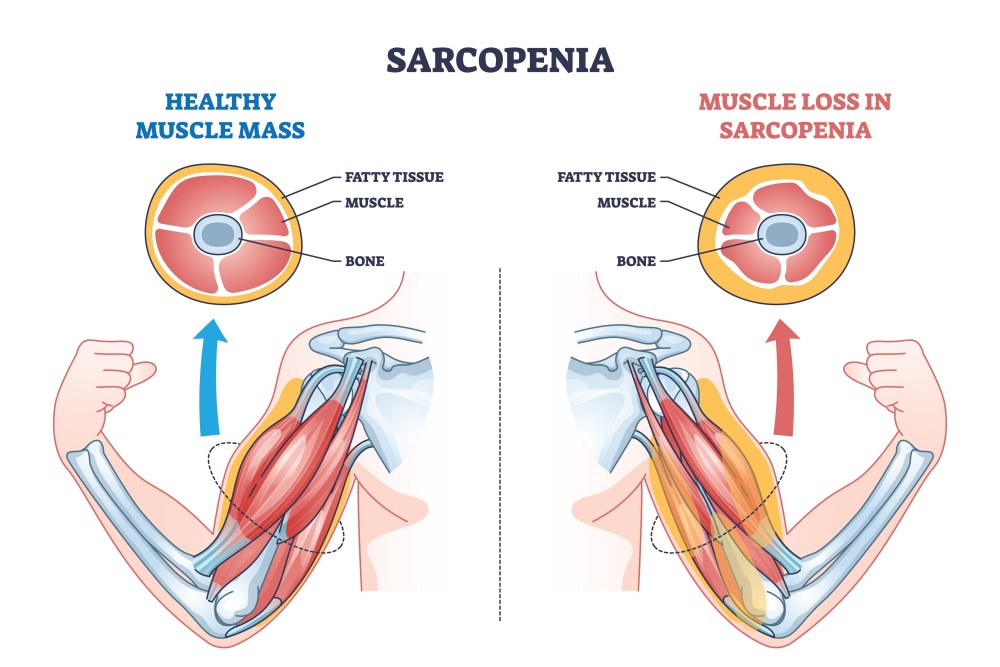Implications Of Sarcopenia On Health And Longevity
It is easy to assume that losing some strength is a “normal part of aging”. In fact, maybe you have even heard this from your healthcare providers. The truth is that getting “weaker” as we age is not “normal” and could be a sign of other medical conditions. Sarcopenia is an “abnormal” loss of muscle mass that must be managed in order for you to live your BEST life well into late adulthood.
In this article, we will go into what sarcopenia is, and things you can start doing today to make sure you avoid this potentially life altering condition.
What Is Sarcopenia?
We gradually lose muscle mass—and strength and function along with it—after we hit 30, seeing a reduction anywhere between 3-8% every decade.
Some lose it more quickly than others, falling prey to sarcopenia.
Sarcopenia is a type of muscle atrophy that comes with the aging process, most commonly affecting people over the age of 60. It can compromise your musculoskeletal system, making you susceptible to frailty, falls, and fractures, increasing your need for institutionalization and hospitalizations, and increasing your risk of mortality.

In addition to causing you to spend $860-$933 extra on healthcare (on average), it can also affect your ability to perform everyday tasks like climbing stairs and lifting objects. Thus, it can lead to a loss of independence, impacting your quality of life.
How many older adults have Sarcopenia?
Sarcopenia is reported to influence the health of up to 16% of older adults over the age of 65%
What Causes Sarcopenia?
Sarcopenia is an age-related condition, but researchers believe it can also happen due to a sedentary lifestyle, where individuals get little to no physical activity. However, as physically active people also develop sarcopenia, other factors may be at play.
These may include:
- A decline in your body’s ability to synthesize protein (anabolic resistance) to energy, leading to a progressive reduction in muscle mass.
- A reduction in nerve cells, particularly ones responsible for carrying messages from your brain to allow muscles to move.
- Chronic illnesses, such as chronic obstructive pulmonary disease (COPD),
- A reduction in hormone levels, such as testosterone, human growth hormone, and insulin-like growth factor.
- Not getting adequate nutrition to sustain muscle mass.
Symptoms Of Sarcopenia
People with sarcopenia may experience the following symptoms:
- A reduction in muscle size
- Loss of stamina/endurance
- Poor balance, which can make them susceptible to falls
- Trouble climbing stairs
- Weakness
They also have difficulty doing physical activities, which can further contribute to muscle mass loss. The loss of muscle mass is linked to insulin resistance and metabolic syndrome. As a result, it can increase fat mass accretion due to low total energy expenditure, making you more susceptible to obesity, diabetes, and hypertension.
So, if you are experiencing these symptoms, instead of treating them as “a normal part of aging”, take a proactive approach, starting with the SARC-F test to assess your risk.
How Is Sarcopenia Diagnosed?
There is no single way to diagnose muscle loss. So, your healthcare provider may start the process by conducting physical tests, such as:
- Chair stand test: It can evaluate leg strength and endurance, especially of the quadriceps. It measures the number of stands a person can complete in 30 seconds without using their arms.
- Handgrip test: This grip power test, which calls for pressing against the dynamometer with all possible force, helps providers identify overall muscle strength. It also tells whether your strength is weakening or just lacking.
- Short Physical Performance Battery (SPPB): This objective assessment test combines three different tasks: walking speed, sit-to-stand, and balance, to evaluate lower extremity strength and functioning.
- Timed-Up and Go Test (TUG): TUG measures the time it takes to stand up from a chair, walk 3 meters (10 feet), turn, walk back to the chair, and sit down. This helps assess a person’s mobility, gait, sway, and stability.
- Walking speed test: It measures the speed you walk a specific distance, which can help providers assess your functional mobility.
These physical tests can help evaluate weakness and assess the objective value of muscle function. But in case the provider needs more information to come to a definitive decision, they may recommend imaging tests, such as:
- Bioelectrical Impedance Analysis (BIA): It is used to measure fat- and fat-free mass to estimate your true body composition.
- Dual-energy X-ray Absorptiometry (DEXA or DXA): It is used to determine bone mineral density, which is an accurate way of determining fracture risk.
Sarcopenia Treatment: All You Need To Know
Sarcopenia could result in longer recovery times from injury, and the worst part is that you won’t get back to your pre-injury levels of functioning. It can severely impact your ability to move around, tanking your social life and increasing loneliness.
Seeing that it’s a progressive disease, you must act now to live a long, healthy life.
Treatment for sarcopenia can include:
Physical Activity
Resistance exercise training can enhance muscle mass and strength, making it the first line of defense for managing sarcopenia. You should go over these exercises in a periodized fashion, taking rest periods between sets to optimize the preservation of exercise intensity and meet your training goals.
The best part?
It will also optimize your hormones, which could help minimize sarcopenia symptoms brought on by hormonal changes like menopause.
Diet
Research conducted on 14,585 individuals aged ≥65 years showed that people who ate 4+ servings of fruit had 40% lower odds of sarcopenia. However, it’s important to note that these benefits extended more to women than men.
That said, a well-balanced diet of high-quality protein, fruits, and vegetables could offer protection against muscle wasting, which may treat the effects of sarcopenia.
Medication
While there are no specific medicinal treatments for sarcopenia, recent clinical trials have focused on the following drugs as possible treatment options:
- Growth hormone supplements: They can restore skeletal muscle protein synthesis and lower age-associated oxidative damage, which may combat the development of sarcopenia.
- Testosterone supplements: A high dose of testosterone could reverse age-related sarcopenia by stimulating cellular metabolism and survival pathways.
- Urocortin II (stresscopin-related peptide): It prevents loss of skeletal muscle mass in normal and atrophying muscles.
Something to remember: These studies are conducted on animal subjects, not humans, so more research is required to back their efficacy on Homo sapiens.
Other treatments under the radar include:
- Angiotensin-converting enzyme inhibitors, which could prevent mitochondrial decline and improve muscle metabolism.
- β-hydroxy-β-methylbutyrate (HMB), which could improve lean muscle mass, strength, and function.
- Vitamin D, which could improve muscle strength and mass.
Apart from these, medications for treating metabolic syndromes may also work—but only when used with resistance training.
In Conclusion
While it’s near impossible to reverse something that has already been brought on by age, you can reduce the severity of the symptoms of sarcopenia by maintaining a healthy weight, eating a nutritious diet, and doing resistance-based exercises. This can improve your quality of life, which can, in turn, reduce your risk of mortality overall.
Spending Time in Nature: Benefits & How to Get Started
In the digital age, people are glued to their phones at all hours of the day. Factor in sedentary lifestyles, and we are damaging our mental and physical well-being. This is why we all need to get out—we mean this in the kindest way possible. Spend time outdoors,...
Decluttering: The Life-Changing Benefits of Tidying Up
One in 11 Americans have so many belongings that they have to pay a sweet $91.14 per month (on average) for storage space outside their homes. It’s not necessarily hoarding—sometimes, they just have difficulty parting with their prized possessions because of the...
Air Purifiers: Impact on health and disease
Our “environment” is one of many ways that it is possible to “leverage” health outcomes. In other words, decrease inflammation (correlated with many diseases) and optimize cell function. “Environmental air pollution has a direct impact on human health, being...
It’s True! Having a Sense of Agency Over One’s Health Can Increase Our Lifespan
Our resilience and it turns out—even our longevity—depends on having a sense of agency over one’s health. When we talk about a sense of agency, we’re referring to having a feeling of control over what happens to us. It’s important because it aids our mental stability,...
Drink Your Way To Good Health With BEAM’s Super Greens
Finding it hard to meet your body’s nutritional needs? You’re not alone. According to the Dietary Reference Intakes, a staggering 92% of Americans suffer from at least one vitamin or mineral deficiency. Deficiencies for most nutrition indicators could be as high as...
Grounding Mats: A Groundbreaking Way To Embrace Good Health
If you’ve ever walked barefoot on the earth, you might have felt recharged and reinvigorated. This sensation isn’t a mere coincidence. Instead, the positive effects we feel when we let our feet touch the Earth’s natural surface—an activity called grounding or...
What Can Blue Zone Residents Teach Us About Life, Health, and Longevity?
Today, we have more scientists, doctors, and nurses. There are also larger investments in healthcare and wellness, more experimental treatments, and more research papers than ever. And yet our world remains riddled with disease and health conditions. Consider that in...
The Miracle of Faith: How It Can Help You Live Longer
“Religion” gets criticized and mocked, but nobody (not even science) can deny it can be good for you. For starters, a study of more than 1,500 newspaper obituaries from across the U.S. shows it can help you live 9.45 years longer than non-spiritual folks. But this...
Looking at the Bright Side: How Optimism Can Help You Live a Longer, Healthier Life
Are you a glass-half-full kind of person? If you are, then you’ll love what this article has to say about its impacts on health. If you struggle to look at the brighter side of things, this could be a sign that it’s time for a change. According to a clinical...
What You Should Know About Sensorineural Hearing Loss
Hearing loss affects millions of people around the globe. According to the World Health Organization (WHO), it is experienced by almost 20% of the entire population! There are three types of hearing loss, but more than 90% are attributed to sensorineural hearing loss....











